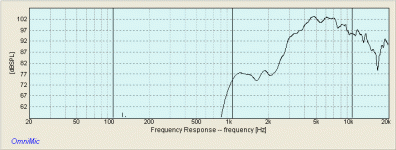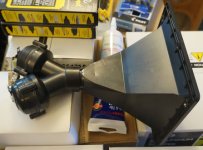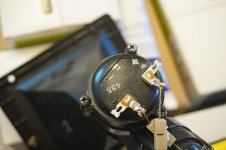I salvaged a pair of mini piezos and was thinking of adding them as super-tweeters.
Do they need a cap? They were originally installed behind 2.2uF?
Do they need a resistor? What does the resistor do?

Do they need a cap? They were originally installed behind 2.2uF?
Do they need a resistor? What does the resistor do?
Since they present a pure capacitance as an impedance, the resistor actually acts like a cap would for a dynamic (magnet - coil) speaker. A resistor forms a high-pass filter when in series. It's sorta counterintuitive.
Frowned upon? Yea. They measure pretty terribly, but above 10K, who cares?
Piezos sound like crap when the designer is lazy and just uses teh natiural LF roll-off od a piezo for the XO. Use dliek that they distort significantly at the lowest part of their range.
dave
dave
Agreed -- they sound fine set up properly, and crossed over well above their minimum. Wayne Parham used them in his PiSpeaker base models until they became unavailable commercially.
Using a transformer with zobel, and hopefully rolling before its resonance, they are amazing.
Otherwise, actively crossed outside of their resonance perhaps with a resistor, some are amazing.
Search djk on audio asylum under the high efficiency forum.
But, true Motorola piezo haven't been made in what, 20 years ?
Otherwise, actively crossed outside of their resonance perhaps with a resistor, some are amazing.
Search djk on audio asylum under the high efficiency forum.
But, true Motorola piezo haven't been made in what, 20 years ?
Try making a frequency response measurement of the piezo. The cheap ones with plastic horn which I tried, had a terrible resonance at 5 kHz.
Sometimes a small piezo is added to a full-range driver. Technically, this makes it a two-way speaker, which it will say on the box. 😉
Sometimes a small piezo is added to a full-range driver. Technically, this makes it a two-way speaker, which it will say on the box. 😉
No, the resistor would be a low pass filter. Usually the cut-off is at around 30 kHz, so it does not really do much acoustically. It is added for the reason stated by @Jeffh01.Since they present a pure capacitance as an impedance, the resistor actually acts like a cap would for a dynamic (magnet - coil) speaker. A resistor forms a high-pass filter when in series. It's sorta counterintuitive.
Last edited:
Just to reiterate >
Adding series resistance to a Piezo does create a low-pass filter. How much you 'hear' depends on the R value.
Adding series capacitance to a Piezo creates volume level reduction. And once again, the value determines what you hear.
The common practice of adding 10 ohms series is to protect BOTH amplifier and driver.
Adding series resistance to a Piezo does create a low-pass filter. How much you 'hear' depends on the R value.
Adding series capacitance to a Piezo creates volume level reduction. And once again, the value determines what you hear.
The common practice of adding 10 ohms series is to protect BOTH amplifier and driver.
PS.
"mini piezos" (without a horn) produce very low output > so they are often used in low cost speakers as
a so called 'super tweeter' but with highly subtle results. They are a very low cost addition, sometimes just for looks.
"mini piezos" (without a horn) produce very low output > so they are often used in low cost speakers as
a so called 'super tweeter' but with highly subtle results. They are a very low cost addition, sometimes just for looks.
with one KSN1016 (original) and stepup transformer I got ~103dB @2.83v input and 1/10 of one percent distortion.
Here''s some application notes from the late and great "DJK" (Dennis
Kleitsch)

Here''s some application notes from the late and great "DJK" (Dennis
Kleitsch)
Last edited by a moderator:
Thank you for all your responses. Whilst the theory seemed like a good idea a practical test proved the obvious. I'm sure the inclusion of the super-tweeter extended the frequency range of the cabinet, I'm no spring chicken - I couldn't hear any difference. @Mister Audio was right - any improvements were purely cosmetic.
Here's a Peavey Piezo CDM horn that's used in many of their speakers.
If I'm not mistaken, the resistor is 50 ohms.
The piezos are Motorola. The cheap ones are very jagged in their response.
I would avoid them.
If I'm not mistaken, the resistor is 50 ohms.
The piezos are Motorola. The cheap ones are very jagged in their response.
I would avoid them.
Attachments
- Home
- Loudspeakers
- Multi-Way
- Are Piezo Tweeters frowned upon?


